2008 GMC SIERRA child seat
[x] Cancel search: child seatPage 55 of 578
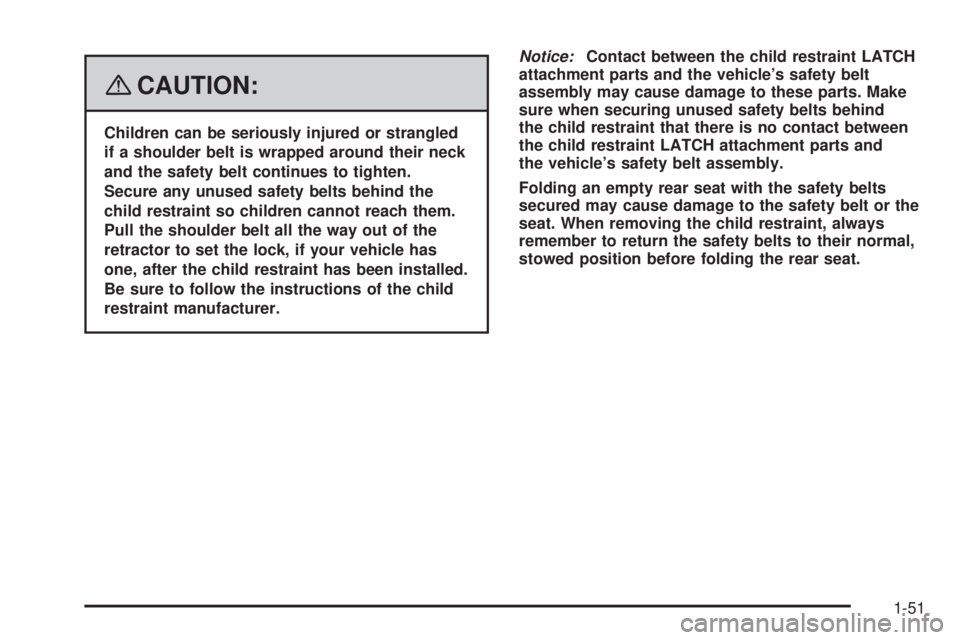
{CAUTION:
Children can be seriously injured or strangled
if a shoulder belt is wrapped around their neck
and the safety belt continues to tighten.
Secure any unused safety belts behind the
child restraint so children cannot reach them.
Pull the shoulder belt all the way out of the
retractor to set the lock, if your vehicle has
one, after the child restraint has been installed.
Be sure to follow the instructions of the child
restraint manufacturer.Notice:Contact between the child restraint LATCH
attachment parts and the vehicle’s safety belt
assembly may cause damage to these parts. Make
sure when securing unused safety belts behind
the child restraint that there is no contact between
the child restraint LATCH attachment parts and
the vehicle’s safety belt assembly.
Folding an empty rear seat with the safety belts
secured may cause damage to the safety belt or the
seat. When removing the child restraint, always
remember to return the safety belts to their normal,
stowed position before folding the rear seat.
1-51
Page 56 of 578

Regular Cab Models
1. If the child restraint manufacturer recommends that
the top tether be attached, attach and tighten the
top tether to the top tether anchor, if your
vehicle has one. Refer to the child restraint
instructions and the following steps:
1.1. Pull the passenger seatback forward by
pulling the recliner handle upward to access
the top tether anchor. SeeReclining
Seatbacks on page 1-8for additional
information.
1.2. Find the top tether anchor.
1.3. Remove the cover to expose the anchor.
1.4. Route, attach, and tighten the top tether
according to your child restraint instructions
and the following instructions:
If the position you are
using has an adjustable
headrest or head restraint
and you are using a
dual tether, route the tether
around the headrest or
head restraint.If the position you are
using has an adjustable
headrest or head restraint
and you are using a
single tether, raise the
headrest or head restraint
and route the tether
under the headrest or head
restraint and in between
the headrest or head
restraint posts.
2. SeeSecuring a Child Restraint in the Right Front
Seat Position (With Airbag Off Switch) on page 1-58
orSecuring a Child Restraint in the Right Front
Seat Position (With Passenger Sensing System) on
page 1-62orSecuring a Child Restraint in the
Right Front Seat Position (Heavy Duty Crew Cab
Only) on page 1-66for instructions on installing the
child restraint using the safety belts.
3. Push and pull the child restraint in different
directions to be sure it is secure.
1-52
Page 57 of 578
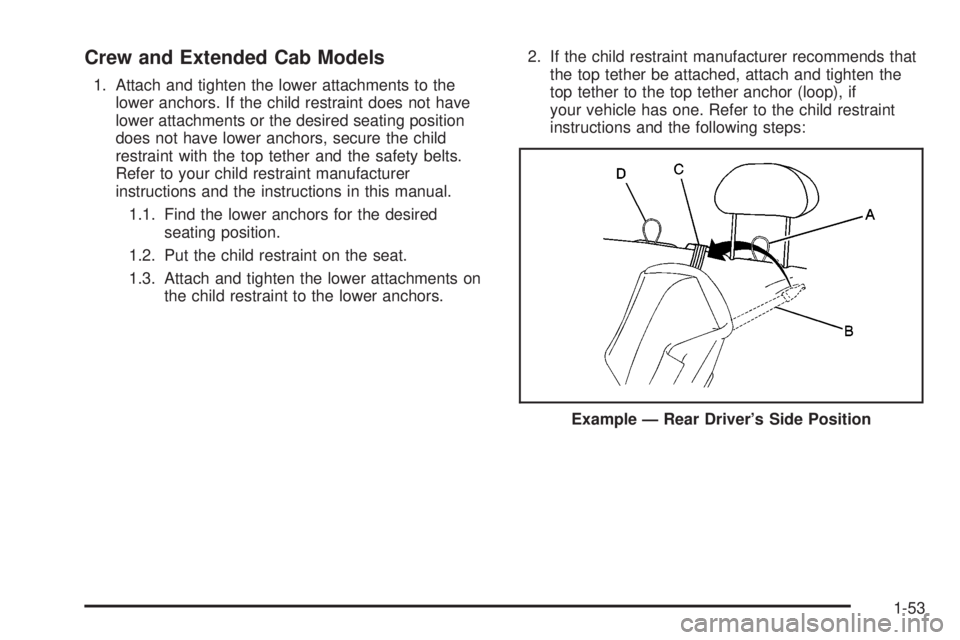
Crew and Extended Cab Models
1. Attach and tighten the lower attachments to the
lower anchors. If the child restraint does not have
lower attachments or the desired seating position
does not have lower anchors, secure the child
restraint with the top tether and the safety belts.
Refer to your child restraint manufacturer
instructions and the instructions in this manual.
1.1. Find the lower anchors for the desired
seating position.
1.2. Put the child restraint on the seat.
1.3. Attach and tighten the lower attachments on
the child restraint to the lower anchors.2. If the child restraint manufacturer recommends that
the top tether be attached, attach and tighten the
top tether to the top tether anchor (loop), if
your vehicle has one. Refer to the child restraint
instructions and the following steps:
Example — Rear Driver’s Side Position
1-53
Page 58 of 578

2.1. When using a child restraint with a top tether
in the rear driver side position:
A. Raise the headrest or head restraint.
B. Route the top tether (B) between
the headrest or head restraint posts,
through the loop (A), behind the inboard
headrest or head restraint post, and
under the center shoulder belt (C).
C. Attach the top tether (B) to the top
tether anchor (loop) (D) at the center
rear seating position.2.2. When using a child restraint with a top tether
in the rear center position:
D. Route the top tether (B) through the
center loop (D), and behind the
inboard passenger side headrest or
head restraint post.
E. Attach the top tether (B) to the top
tether anchor (loop) at the rear
passenger side seating position.
2.3. When using a child restraint with a top tether
in the rear passenger position:
F. Raise the headrest or head restraint.
G. Route the top tether (B) between
the headrest or head restraint
posts, through the loop on the
passenger side and behind the inboard
headrest or head restraint post.
H. Attach the top tether (B) to the top
tether anchor (loop) (D) at the center
rear seating position.
2.4. Tighten the top tether when and as the child
restraint manufacturer’s instructions say.
When the top tether is tightened, the anchor
(loop) may bend. This is normal and will
not damage the vehicle.
3. Push and pull the child restraint in different
directions to be sure it is secure. Example — Rear Driver’s Side Position
1-54
Page 59 of 578
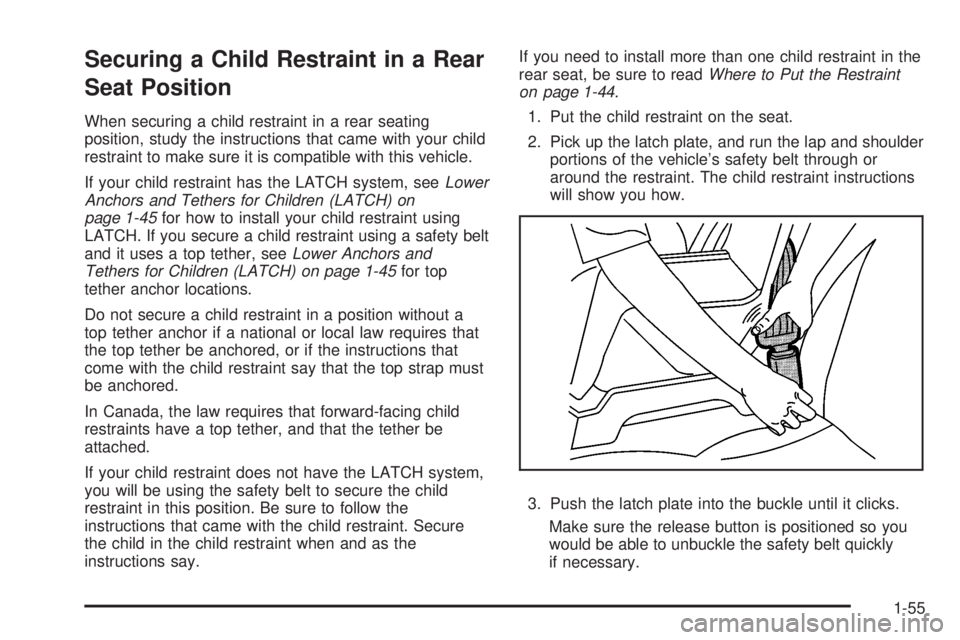
Securing a Child Restraint in a Rear
Seat Position
When securing a child restraint in a rear seating
position, study the instructions that came with your child
restraint to make sure it is compatible with this vehicle.
If your child restraint has the LATCH system, seeLower
Anchors and Tethers for Children (LATCH) on
page 1-45for how to install your child restraint using
LATCH. If you secure a child restraint using a safety belt
and it uses a top tether, seeLower Anchors and
Tethers for Children (LATCH) on page 1-45for top
tether anchor locations.
Do not secure a child restraint in a position without a
top tether anchor if a national or local law requires that
the top tether be anchored, or if the instructions that
come with the child restraint say that the top strap must
be anchored.
In Canada, the law requires that forward-facing child
restraints have a top tether, and that the tether be
attached.
If your child restraint does not have the LATCH system,
you will be using the safety belt to secure the child
restraint in this position. Be sure to follow the
instructions that came with the child restraint. Secure
the child in the child restraint when and as the
instructions say.If you need to install more than one child restraint in the
rear seat, be sure to readWhere to Put the Restraint
on page 1-44.
1. Put the child restraint on the seat.
2. Pick up the latch plate, and run the lap and shoulder
portions of the vehicle’s safety belt through or
around the restraint. The child restraint instructions
will show you how.
3. Push the latch plate into the buckle until it clicks.
Make sure the release button is positioned so you
would be able to unbuckle the safety belt quickly
if necessary.
1-55
Page 61 of 578
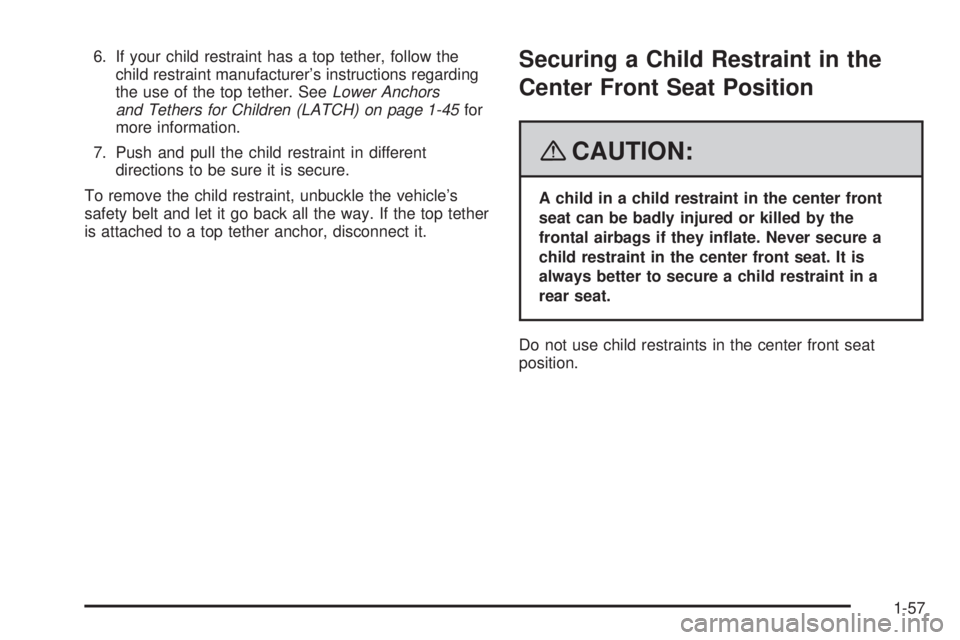
6. If your child restraint has a top tether, follow the
child restraint manufacturer’s instructions regarding
the use of the top tether. SeeLower Anchors
and Tethers for Children (LATCH) on page 1-45for
more information.
7. Push and pull the child restraint in different
directions to be sure it is secure.
To remove the child restraint, unbuckle the vehicle’s
safety belt and let it go back all the way. If the top tether
is attached to a top tether anchor, disconnect it.Securing a Child Restraint in the
Center Front Seat Position
{CAUTION:
A child in a child restraint in the center front
seat can be badly injured or killed by the
frontal airbags if they in�ate. Never secure a
child restraint in the center front seat. It is
always better to secure a child restraint in a
rear seat.
Do not use child restraints in the center front seat
position.
1-57
Page 62 of 578
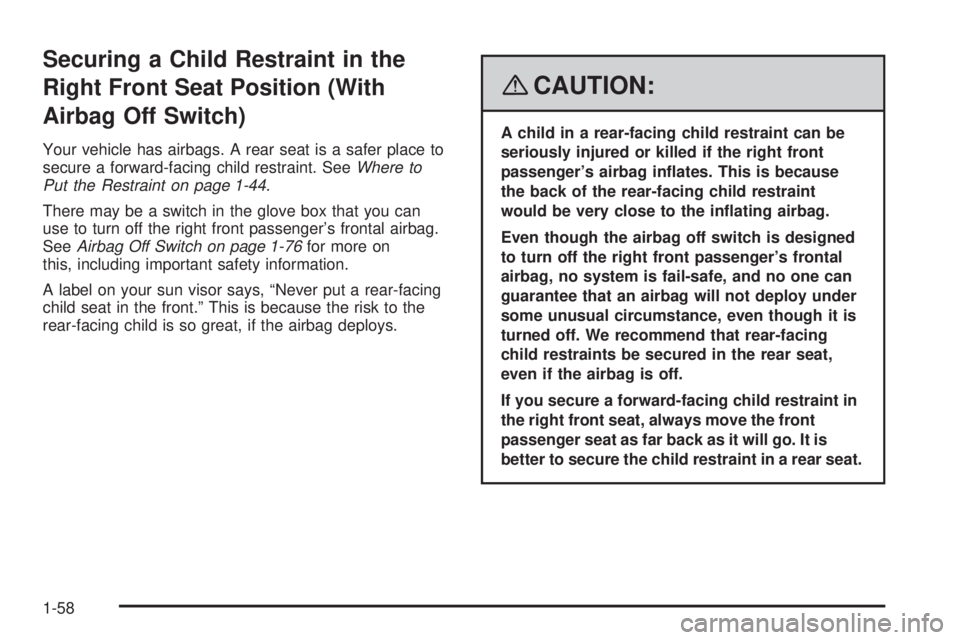
Securing a Child Restraint in the
Right Front Seat Position (With
Airbag Off Switch)
Your vehicle has airbags. A rear seat is a safer place to
secure a forward-facing child restraint. SeeWhere to
Put the Restraint on page 1-44.
There may be a switch in the glove box that you can
use to turn off the right front passenger’s frontal airbag.
SeeAirbag Off Switch on page 1-76for more on
this, including important safety information.
A label on your sun visor says, “Never put a rear-facing
child seat in the front.” This is because the risk to the
rear-facing child is so great, if the airbag deploys.
{CAUTION:
A child in a rear-facing child restraint can be
seriously injured or killed if the right front
passenger’s airbag in�ates. This is because
the back of the rear-facing child restraint
would be very close to the in�ating airbag.
Even though the airbag off switch is designed
to turn off the right front passenger’s frontal
airbag, no system is fail-safe, and no one can
guarantee that an airbag will not deploy under
some unusual circumstance, even though it is
turned off. We recommend that rear-facing
child restraints be secured in the rear seat,
even if the airbag is off.
If you secure a forward-facing child restraint in
the right front seat, always move the front
passenger seat as far back as it will go. It is
better to secure the child restraint in a rear seat.
1-58
Page 63 of 578
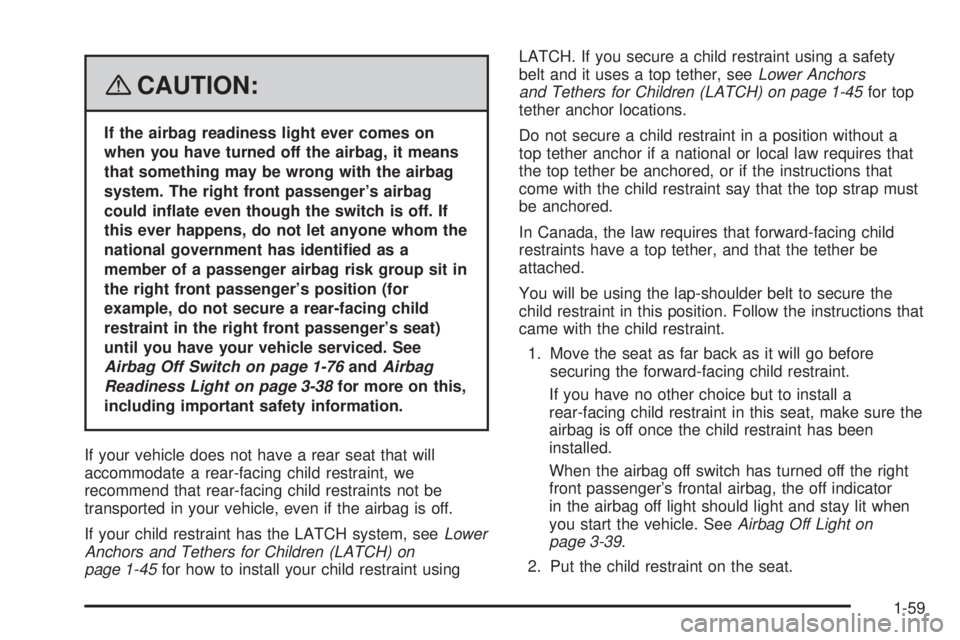
{CAUTION:
If the airbag readiness light ever comes on
when you have turned off the airbag, it means
that something may be wrong with the airbag
system. The right front passenger’s airbag
could in�ate even though the switch is off. If
this ever happens, do not let anyone whom the
national government has identi�ed as a
member of a passenger airbag risk group sit in
the right front passenger’s position (for
example, do not secure a rear-facing child
restraint in the right front passenger’s seat)
until you have your vehicle serviced. See
Airbag Off Switch on page 1-76andAirbag
Readiness Light on page 3-38for more on this,
including important safety information.
If your vehicle does not have a rear seat that will
accommodate a rear-facing child restraint, we
recommend that rear-facing child restraints not be
transported in your vehicle, even if the airbag is off.
If your child restraint has the LATCH system, seeLower
Anchors and Tethers for Children (LATCH) on
page 1-45for how to install your child restraint usingLATCH. If you secure a child restraint using a safety
belt and it uses a top tether, seeLower Anchors
and Tethers for Children (LATCH) on page 1-45for top
tether anchor locations.
Do not secure a child restraint in a position without a
top tether anchor if a national or local law requires that
the top tether be anchored, or if the instructions that
come with the child restraint say that the top strap must
be anchored.
In Canada, the law requires that forward-facing child
restraints have a top tether, and that the tether be
attached.
You will be using the lap-shoulder belt to secure the
child restraint in this position. Follow the instructions that
came with the child restraint.
1. Move the seat as far back as it will go before
securing the forward-facing child restraint.
If you have no other choice but to install a
rear-facing child restraint in this seat, make sure the
airbag is off once the child restraint has been
installed.
When the airbag off switch has turned off the right
front passenger’s frontal airbag, the off indicator
in the airbag off light should light and stay lit when
you start the vehicle. SeeAirbag Off Light on
page 3-39.
2. Put the child restraint on the seat.
1-59